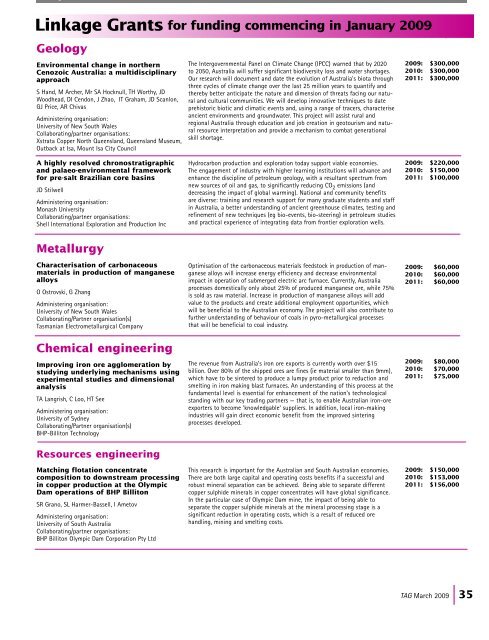The case for a greenfields renaissance Feature - Geological Society ...
The case for a greenfields renaissance Feature - Geological Society ...
The case for a greenfields renaissance Feature - Geological Society ...
Create successful ePaper yourself
Turn your PDF publications into a flip-book with our unique Google optimized e-Paper software.
PROJECT SUMMARY GRANT<br />
Linkage Grants <strong>for</strong> funding commencing in January 2009<br />
Geology<br />
Environmental change in northern<br />
Cenozoic Australia: a multidisciplinary<br />
approach<br />
S Hand, M Archer, Mr SA Hocknull, TH Worthy, JD<br />
Woodhead, DI Cendon, J Zhao, IT Graham, JD Scanlon,<br />
GJ Price, AR Chivas<br />
Administering organisation:<br />
University of New South Wales<br />
Collaborating/partner organisations:<br />
Xstrata Copper North Queensland, Queensland Museum,<br />
Outback at Isa, Mount Isa City Council<br />
<strong>The</strong> Intergovernmental Panel on Climate Change (IPCC) warned that by 2020<br />
to 2050, Australia will suffer significant biodiversity loss and water shortages.<br />
Our research will document and date the evolution of Australia's biota through<br />
three cycles of climate change over the last 25 million years to quantify and<br />
thereby better anticipate the nature and dimension of threats facing our natural<br />
and cultural communities. We will develop innovative techniques to date<br />
prehistoric biotic and climatic events and, using a range of tracers, characterise<br />
ancient environments and groundwater. This project will assist rural and<br />
regional Australia through education and job creation in geotourism and natural<br />
resource interpretation and provide a mechanism to combat generational<br />
skill shortage.<br />
2009: $300,000<br />
2009: $300,000<br />
2010: $300,000<br />
2011: $300,000<br />
A highly resolved chronostratigraphic<br />
and palaeo-environmental framework<br />
<strong>for</strong> pre-salt Brazilian core basins<br />
JD Stilwell<br />
Administering organisation:<br />
Monash University<br />
Collaborating/partner organisations:<br />
Shell International Exploration and Production Inc<br />
Hydrocarbon production and exploration today support viable economies.<br />
<strong>The</strong> engagement of industry with higher learning institutions will advance and<br />
enhance the discipline of petroleum geology, with a resultant spectrum from<br />
new sources of oil and gas, to significantly reducing CO 2 emissions (and<br />
decreasing the impact of global warming). National and community benefits<br />
are diverse: training and research support <strong>for</strong> many graduate students and staff<br />
in Australia, a better understanding of ancient greenhouse climates, testing and<br />
refinement of new techniques (eg bio-events, bio-steering) in petroleum studies<br />
and practical experience of integrating data from frontier exploration wells.<br />
2009: $220,000<br />
2010: $150,000<br />
2011: $100,000<br />
Metallurgy<br />
Characterisation of carbonaceous<br />
materials in production of manganese<br />
alloys<br />
O Ostrovski, G Zhang<br />
Administering organisation:<br />
University of New South Wales<br />
Collaborating/Partner organisation(s)<br />
Tasmanian Electrometallurgical Company<br />
Optimisation of the carbonaceous materials feedstock in production of manganese<br />
alloys will increase energy efficiency and decrease environmental<br />
impact in operation of submerged electric arc furnace. Currently, Australia<br />
processes domestically only about 25% of produced manganese ore, while 75%<br />
is sold as raw material. Increase in production of manganese alloys will add<br />
value to the products and create additional employment opportunities, which<br />
will be beneficial to the Australian economy. <strong>The</strong> project will also contribute to<br />
further understanding of behaviour of coals in pyro-metallurgical processes<br />
that will be beneficial to coal industry.<br />
2009: $60,000<br />
2010: $60,000<br />
2011: $60,000<br />
Chemical engineering<br />
Improving iron ore agglomeration by<br />
studying underlying mechanisms using<br />
experimental studies and dimensional<br />
analysis<br />
TA Langrish, C Loo, HT See<br />
Administering organisation:<br />
University of Sydney<br />
Collaborating/Partner organisation(s)<br />
BHP-Billiton Technology<br />
<strong>The</strong> revenue from Australia's iron ore exports is currently worth over $15<br />
billion. Over 80% of the shipped ores are fines (ie material smaller than 9mm),<br />
which have to be sintered to produce a lumpy product prior to reduction and<br />
smelting in iron making blast furnaces. An understanding of this process at the<br />
fundamental level is essential <strong>for</strong> enhancement of the nation's technological<br />
standing with our key trading partners — that is, to enable Australian iron-ore<br />
exporters to become 'knowledgable' suppliers. In addition, local iron-making<br />
industries will gain direct economic benefit from the improved sintering<br />
processes developed.<br />
2009: $80,000<br />
2010: $70,000<br />
2011: $75,000<br />
Resources engineering<br />
Matching flotation concentrate<br />
composition to downstream processing<br />
in copper production at the Olympic<br />
Dam operations of BHP Billiton<br />
SR Grano, SL Harmer-Bassell, I Ametov<br />
Administering organisation:<br />
University of South Australia<br />
Collaborating/partner organisations:<br />
BHP Billiton Olympic Dam Corporation Pty Ltd<br />
This research is important <strong>for</strong> the Australian and South Australian economies.<br />
<strong>The</strong>re are both large capital and operating costs benefits if a successful and<br />
robust mineral separation can be achieved. Being able to separate different<br />
copper sulphide minerals in copper concentrates will have global significance.<br />
In the particular <strong>case</strong> of Olympic Dam mine, the impact of being able to<br />
separate the copper sulphide minerals at the mineral processing stage is a<br />
significant reduction in operating costs, which is a result of reduced ore<br />
handling, mining and smelting costs.<br />
2009: $150,000<br />
2010: $153,000<br />
2011: $156,000<br />
TAG March 2009 | 35

















